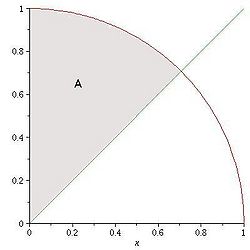Science:Math Exam Resources/Courses/MATH103/April 2012/Question 03 (a)
{{#incat:MER QGQ flag|{{#incat:MER QGH flag|{{#incat:MER QGS flag|}}}}}}
• Q1 (a) • Q1 (b) • Q1 (c) • Q1 (d) • Q1 (e) • Q1 (f) • Q1 (g) • Q2 (a) • Q2 (b) • Q2 (c) • Q2 (d) • Q2 (e) • Q2 (f) • Q3 (a) • Q3 (b) • Q4 (a) • Q4 (b) • Q4 (c) • Q4 (d) • Q4 (e) • Q4 (f) • Q5 (a) • Q5 (b) • Q5 (c) •
Question 03 (a) |
|---|
|
Consider the area A between a circle of radius 1 in the first quadrant and ƒ(x)=x. Find the volume of the solid obtained by rotating A about the x-axis. |
|
Make sure you understand the problem fully: What is the question asking you to do? Are there specific conditions or constraints that you should take note of? How will you know if your answer is correct from your work only? Can you rephrase the question in your own words in a way that makes sense to you? |
|
If you are stuck, check the hint below. Consider it for a while. Does it give you a new idea on how to approach the problem? If so, try it! |
Hint |
|---|
|
Because the expression is a function for x and is to be rotated about the x-axis, we should use the disc method. When using the disc method, we want to evaluate the integral where a and b are the smallest and largest values of x in the region, f(x) is the largest y-value in the region at x (which will be the outer radius of the disc) , and g(x) is the smallest y-value in the region at x (which will be the inner radius of the disc). For this region, we have that . The rightmost x-value is the point of intersection of the circle and the line . Try to find the value of b and evaluate the integral. |
|
Checking a solution serves two purposes: helping you if, after having used the hint, you still are stuck on the problem; or if you have solved the problem and would like to check your work.
|
Solution |
|---|
|
The equation of a circle with radius 1 is x2+y2=1 or, once we solve for , (which gives the upper half of the circle). Because we are rotating around the x-axis, we will be integrating between two points on the x-axis. The left endpoint is clearly 0. The right endpoint is a little trickier: it will be the point where and intersect. This point of intersection is found by setting these two curves equal and solving:
Because we are in the first quadrant, the intersection point must be positive. Thus we will be integrating between and If we use the Disc Method, the outside radius of the disc will be the arc of the circle, given by and the inside radius will be given by the line . Plugging these, and our endpoints, into the integral, we get: |
{{#incat:MER CT flag||
}}

![{\displaystyle \pi \int _{a}^{b}[f(x)^{2}-g(x)^{2}]dx}](https://wiki.ubc.ca/api/rest_v1/media/math/render/svg/11801c2568b91f70cc38e03b10eb6f669416131d)









![{\displaystyle {\begin{aligned}V&=\int _{0}^{\frac {1}{\sqrt {2}}}\pi \left[\left({\sqrt {1-x^{2}}}\right)^{2}-\left(x\right)^{2}\right]dx\\&=\int _{0}^{\frac {1}{\sqrt {2}}}\pi \left[1-2x^{2}\right]dx\\&=\pi \left[x-{\frac {2x^{3}}{3}}\right]_{0}^{\frac {1}{\sqrt {2}}}\\&=\pi \left[{\frac {1}{\sqrt {2}}}-{\frac {1}{3{\sqrt {2}}}}\right]\\&={\frac {\sqrt {2}}{3}}\pi \end{aligned}}}](https://wiki.ubc.ca/api/rest_v1/media/math/render/svg/161917126d0cd6dead1ee20442b4fff635ea1029)
